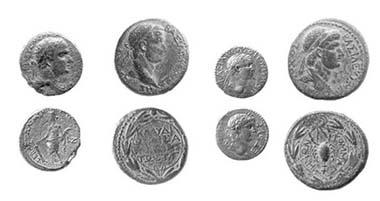by David Hendin
Josephus tells us of a most interesting meeting in Tiberias, apparently convened by Agrippa I (37-44 CE), grandson of Herod the Great, probably around 42 CE.
The prelude to this meeting took place shortly after Agrippa built a “sumptuous and elegant” theatre in Berytus and when it was finished he staged a giant gala/execution in which 1,400 “malefactors” were punished by being pitted against each other, 700 versus 700, as gladiators, “And thus were these criminals all destroyed at once.”
Agrippa’s meeting at Tiberias in the Galilee was attended by six rulers of the ancient near east. We can see four of their portraits on the coins they struck (from left): Agrippa I himself, shown on a 21 mm bronze coin struck in Caesarea in 42/43 CE, Hendin-555; his brother, Herod of Chalcis, shown on a 26 mm bronze coin struck circa 43 CE in Chalcis, Hendin-561; Polemo, King of Pontus, shown on a 17.5 mm silver drachma struck in 56/57 CE in Pontus, Hendin-931; and Antiochus IV of Commagene, shown on a 27 mm bronze coin struck in Commagene during his reign (38-72 CE).
Now comes the meeting:
“When Agrippa had finished what I have above related at Berytus, he removed to Tiberias, a city of Galilee. Now he was in great esteem among other kings. Accordingly there came to him Antiochus, king of Commagena, Sampsigeramus, king of Emisa, and Cotys, who was king of the Lesser Armenia, and Polemo, who was king of Pontus, as also Herod his brother, who was king of Chalcis.
“All these he treated with agreeable entertainments, and after an obliging manner, and so as to exhibit the greatness of his mind—and so as to appear worthy of those respects which the kinds paid to him, by coming to see him.”
This meeting apparently ended in something of a disaster, because Josephus tells us that during this very meeting, “Marcus, the president of Syria [no doubt he was the legate or the governor, although the coins of Antioch of this period do not reveal a legate with this name], came thither. So the king, in order to preserve the respect that was due to the Romans, went out of the city to meet him, as far as seven furlongs. But this proved to be the beginning of a difference between him and Marcus; for he took with him in his chariot those other kings as his assessors. But Marcus had a suspicion what the meaning could be of so great a friendship of these kings one with another, and did not think so close an agreement of so many potentates to be for the interest of the Romans. He therefore sent some of his domestics to every one of them, and enjoined them to go their ways home without further delay. This was very ill taken by Agrippa, who after that became his enemy.”
This story is contained in the same chapter that describes Agrippa’s death (Antiquities XIX, VIII), so it apparently happened quite late in his life, probably around 42 CE, less than two years before his death.
Nevertheless, the story of this meeting of the kings gives us an interesting look at the potential alliances between the men who ruled at the pleasure of Rome during the first century, not to mention how very nervous those alliances made the local Roman representatives.
It is especially interesting that we can actually see some of these rulers via portraits on their coins, specifically Agrippa himself, Antiochus IV of Commagene, Polemo King of Pontus (who, after Agrippa’s death, would become the third husband of Agrippa’s daughter Berenice), and Agrippa’s brother, Herod of Chalcis (who later became the second husband of Agrippa’s daughter Berenice).
by courtesy of David Hendin, Copyright 2001 by David Hendin, all rights reserved.
If you want to know more about David Hendin, specialist for Jewish coin, please visit his website and click here.




